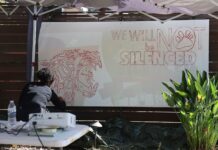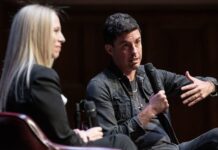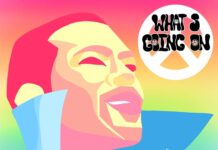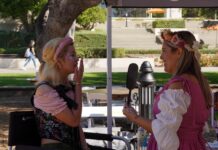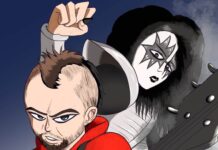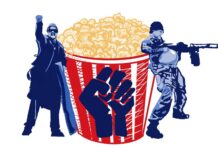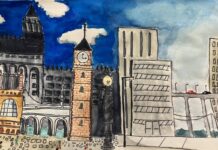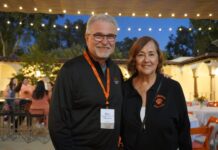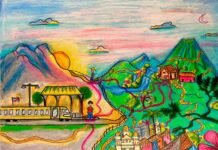Author:
The faculty and students of Oxy’s AHVA Film & Media Studies Program have put together a bimonthly Oxy Cinematheque screening series this fall to bring students across campus together around a sampling of films and videos selected for their resonance with this semester’s courses, current events and larger matters of film history and culture. At the moment, there is a burgeoning interest in documentaries across campus from both students and faculty. Many students seem to feel however that to make a documentary one must travel overseas and point the camera at those of another culture. On October 3, we screened Silverlake Life: The View From Here, a 1993 documentary I recommended for inclusion in the series. As the title suggests, Silverlake Life is a film made in, and about a community literally in Occidental’s own backyard.
The video offers a powerful and humanizing look at the AIDS crisis at its late ’80s/early ’90s American peak. Silverlake resident and filmmaker Tom Joslin decided to document his partner Mark Massi’s battle with AIDS as a means of coping, and the resultant document was one of the first films to put a face to the AIDS crisis. In addition, it broke barriers in showing a committed, gay partnership in a time of government apathy, cultural fear and rampant homophobia and stigmatization. The film challenges assumptions about amateur/professional production divides and pushes cinematic representation to its limit in depicting death on camera (that of filmmaker Tom Joslin, no less). Silverlake Life thereby raises interesting conversations about authorship, as the camera and the promise to finish Tom’s film is first passed to its once subject-his partner of 20 years Mark Massi-and after Mark’s death, to one of Tom’s former film students, Peter Friedman.
Walking over to Johnson 200 to introduce the film, I was startled to hear a shout of, “Hey, faggots!” Looking up, I saw Oxy students in a BMW pull over in front of Weingart to pick up two passing male peers and then drive off up the hill to the dorms above. Apparently this shout was meant as some sort of “normal” salutation from one friend to his buddies.
Arriving at Johnson Hall, I found a cluster of CSP 99 students outside the door, hesitating to go in. An approaching young man called out to the huddle, “You all going to the movie?” A girl in the pack turned with a smirk/snort and responded, “Well . . . we just found out it’s about gay guys with AIDS. So . . .” Assorted eye rolling and laughter ensued.
Passing by her at this moment, I turned and faced this young woman; told her that yes indeed the video was about two gay men with AIDS. Was that something that made her uncomfortable or that she found difficult to handle? She did not respond. I told her the film was a compelling and important one, and that I hoped she would stay and give it a chance. This was met with a red face, silence and finally a bout of hysterical (nervous?) laughter that continued outside Johnson 200 for the next few minutes before the screening began, as she and her friends digested (dismissed?) our exchange.
As this week marks National Coming Out Week (October 7-11, 2007), I must say these two experiences in such proximity to one another have me pondering the “Oxy Bubble” I hear much talk about. Is this a bubble that keeps Occidental separate from real-world sociopolitical issues that happen off campus, or is it rather that each of us encased in our own bubble inside the Oxy Bubble?
There is also much talk of facilitating diversity on campus. This means different things to different people, and at its worst I fear the meaning gets reduced to one of political correctness-of silencing speech and dialogue about important matters rather than tabling and working through them in some substantive and meaningful fashion. Along this path of least resistance, diversity becomes a matter of being careful not to say “faggot” too loudly during the seven days out of 365 we annually set aside as Coming Out Week. Or it leads to keeping one’s assumptions or valid questions about race, class, gender, religion and other monikers of identity silent and unevolved lest they be misconstrued as intolerant or offensive.
I write this as an invitation for every student, faculty or staff member and administrator to celebrate Coming Out Week in a specific and personal way this year. Each of us was born with at least one biological sex and since then has cultivated an internal conception of gender and an external matrix of signs by which we choose to perform gender. Each of us has a sexuality and a way in which we define family, partnership, love, desire and relationships. Each of us has a race, a religious and cultural heritage and a national identity. I ask us all to look critically within ourselves at what we consider “normal” during Coming Out Week; at what makes us designate a certain set of behaviors and permutations of identity as “normal” and anything beyond these deviant or foreign.
To the young man who shouted “Hey, faggots!” and to the friends who responded as if this were a normal “Hello,” where and how did you arrive upon this as a normative salutation used to greet friends? To the girl, who learning the subject matter of Silverlake Life immediately assumed a shared lack of interest or relevance to her or her friends, what was it that turned you away? A notion that all “good” movies should be funny and escapist? A sense that you yourself are immune from AIDS, mortality, persecution, denial of medical care or civil liberties? Or do you empathize with and exist in a similar bubble to a faculty colleague who once quipped, “Identity politics is so over”?
In short, far from asking us to be politically correct or to momentarily hold hands under duress for a fear-based, pressure-cooked, off-key rendition of “Kumbaya” (a song that aside from its popular dilution has powerful roots linked very much to identity politics), I encourage each of us to “come out” of our own bubble, thinking and speaking critically about who we are, where we come from, what we deem “normal” and why.
I close with words originally attributed to German Pastor Martin Niemöller, but rightfully recruited and paraphrased by many since:
When the Nazis came for the communists, I remained silent;
I was not a communist.
When they locked up the social democrats, I remained silent;
I was not a social democrat.
When they came for the trade unionists, I did not speak out;
I was not a trade unionist.
When they came for the Jews, I remained silent;
I wasn’t a Jew.
When they came for me, there was no one left to speak out.
And if after reading these words you shrug, thinking, “I’m not a communist, I don’t know what a social democrat or a trade unionist is and I’m not Jewish,” be careful not to pop your bubble as you turn this page.
This article has been archived, for more requests please contact us via the support system.
![]()


